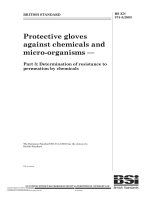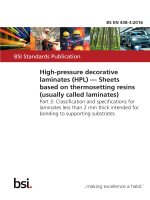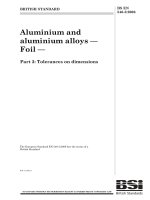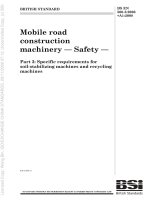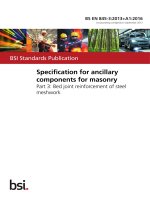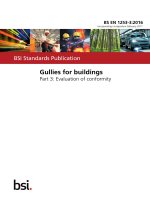Bsi bs en 61076 3 120 2016
Bạn đang xem bản rút gọn của tài liệu. Xem và tải ngay bản đầy đủ của tài liệu tại đây (2.71 MB, 32 trang )
BS EN 61076-3-120:2016
BSI Standards Publication
Connectors for electronic
equipment — Product
requirements
Part 3-120: Rectangular connectors — Detail
specification for rewirable power connectors
with snap locking for rated voltage of
250 V d.c. and rated current of 30 A
BRITISH STANDARD
BS EN 61076-3-120:2016
National foreword
This British Standard is the UK implementation of EN 61076-3-120:2016. It
is identical to IEC 61076-3-120:2016.
The UK participation in its preparation was entrusted to Technical
Committee EPL/48, Electromechanical components and mechanical
structures for electronic equipment.
A list of organizations represented on this committee can be obtained on
request to its secretary.
This publication does not purport to include all the necessary provisions of
a contract. Users are responsible for its correct application.
© The British Standards Institution 2017.
Published by BSI Standards Limited 2017
ISBN 978 0 580 87758 2
ICS 31.220.10
Compliance with a British Standard cannot confer immunity from
legal obligations.
This British Standard was published under the authority of the
Standards Policy and Strategy Committee on 31 January 2017.
Amendments/corrigenda issued since publication
Date
Text affected
BS EN 61076-3-120:2016
EUROPEAN STANDARD
EN 61076-3-120
NORME EUROPÉENNE
EUROPÄISCHE NORM
December 2016
ICS 31.220.10
English Version
Connectors for electronic equipment - Product requirements Part 3-120: Rectangular connectors - Detail specification for
rewirable power connectors with snap locking for rated voltage of
250 V d.c. and rated current of 30 A
(IEC 61076-3-120:2016)
Connecteurs pour équipements électroniques - Exigences
de produit - Partie 3-120: Connecteurs rectangulaires Spécification particulière pour connecteurs de puissance
démontables à encliquetage pour une tension continue
assignée de 250 V et un courant assigné de 30 A
(IEC 61076-3-120:2016)
Steckverbinder für elektronische Einrichtungen Produktanforderungen - Teil 3-120: Rechteckige
Steckverbinder - Bauartspezifikation für
wiederanschließbare Leistungssteckverbinder mit
Rastverriegelung für 250 V Bemessungsgleichspannung
und einen Bemessungsstrom von 30 A
(IEC 61076-3-120:2016)
This European Standard was approved by CENELEC on 2016-09-29. CENELEC members are bound to comply with the CEN/CENELEC
Internal Regulations which stipulate the conditions for giving this European Standard the status of a national standard without any alteration.
Up-to-date lists and bibliographical references concerning such national standards may be obtained on application to the CEN-CENELEC
Management Centre or to any CENELEC member.
This European Standard exists in three official versions (English, French, German). A version in any other language made by translation
under the responsibility of a CENELEC member into its own language and notified to the CEN-CENELEC Management Centre has the
same status as the official versions.
CENELEC members are the national electrotechnical committees of Austria, Belgium, Bulgaria, Croatia, Cyprus, the Czech Republic,
Denmark, Estonia, Finland, Former Yugoslav Republic of Macedonia, France, Germany, Greece, Hungary, Iceland, Ireland, Italy, Latvia,
Lithuania, Luxembourg, Malta, the Netherlands, Norway, Poland, Portugal, Romania, Slovakia, Slovenia, Spain, Sweden, Switzerland,
Turkey and the United Kingdom.
European Committee for Electrotechnical Standardization
Comité Européen de Normalisation Electrotechnique
Europäisches Komitee für Elektrotechnische Normung
CEN-CENELEC Management Centre: Avenue Marnix 17, B-1000 Brussels
© 2016 CENELEC All rights of exploitation in any form and by any means reserved worldwide for CENELEC Members.
Ref. No. EN 61076-3-120:2016 E
BS EN 61076-3-120:2016
EN 61076-3-120:2016
European foreword
The text of document 48B/2498/FDIS, future edition 1 of IEC 61076-3-120, prepared by SC 48B
"Electrical connectors", of IEC/TC 48 "Electrical connectors and mechanical structures for electrical
and electronic equipment" was submitted to the IEC-CENELEC parallel vote and approved by
CENELEC as EN 61076-3-120:2016.
The following dates are fixed:
•
latest date by which the document has to be implemented at
national level by publication of an identical national
standard or by endorsement
(dop)
2017-06-29
•
latest date by which the national standards conflicting with
the document have to be withdrawn
(dow)
2019-09-29
Attention is drawn to the possibility that some of the elements of this document may be the subject of
patent rights. CENELEC [and/or CEN] shall not be held responsible for identifying any or all such
patent rights.
Endorsement notice
The text of the International Standard IEC 61076-3-120:2016 was approved by CENELEC as a
European Standard without any modification.
In the official version, for Bibliography, the following notes have to be added for the standards indicated:
2
IEC 60352-7
NOTE
Harmonized as EN 60352-7.
IEC 60512-1-100
NOTE
Harmonized as EN 60512-1-100.
IEC 60999-2:2003
NOTE
Harmonized as EN 60999-2:2003 (not modified).
ISO 11469:2000
NOTE
Harmonized as EN ISO 11469:2000 (not modified).
BS EN 61076-3-120:2016
EN 61076-3-120:2016
Annex ZA
(normative)
Normative references to international publications
with their corresponding European publications
The following documents, in whole or in part, are normatively referenced in this document and are
indispensable for its application. For dated references, only the edition cited applies. For undated
references, the latest edition of the referenced document (including any amendments) applies.
NOTE 1
When an International Publication has been modified by common modifications, indicated by (mod),
the relevant EN/HD applies.
NOTE 2
Up-to-date information on the latest versions of the European Standards listed in this annex is
available here: www.cenelec.eu.
Publication
Year
Title
EN/HD
Year
IEC 60050-581
2008
International Electrotechnical
Vocabulary (IEV) Part 581: Electromechanical
components for electronic equipment
-
-
IEC 60068-1
-
Environmental testing Part 1: General and guidance
EN 60068-1
-
IEC 60228
2004
Conductors of insulated cables
EN 60228
2005
-
-
+ corr. May
2005
IEC 60352
series
Solderless connections
EN 60352
series
IEC 60512
series
Connectors for electronic equipment Tests and measurements
EN 60512
series
IEC 60512-1-2
2002
Connectors for electronic equipment Tests and measurements Part 1-2: General examination - Test 1b:
Examination of dimension and mass
EN 60512-1-2
2002
IEC 60999-1
1999
Connecting devices - Electrical copper
conductors - Safety requirements for
screw-type and screwless-type clamping
units Part 1: General requirements and
particular requirements for clamping
units for conductors from 0,2 mm² up to
35 mm² (included)
EN 60999-1
2000
IEC 61076-1
2006
Connectors for electronic equipment Product requirements Part 1: Generic specification
EN 61076-1
2006
IEC 61076-3
2008
Connectors for electronic equipment Product requirements Part 3: Rectangular connectors Sectional specification
EN 61076-3
2008
3
BS EN 61076-3-120:2016
EN 61076-3-120:2016
Publication
Year
Title
EN/HD
Year
IEC 61984
2008
Connectors - Safety requirements and
tests
EN 61984
2009
IEC 62430
-
Environmentally conscious design for
electrical and electronic products
EN 62430
-
IEC Guide 109
-
Environmental aspects - Inclusion in
electrotechnical product standards
-
-
4
–2–
BS EN 61076-3-120:2016
IEC 61076-3-120:2016 © IEC 2016
CONTENTS
FOREWORD ......................................................................................................................... 4
INTRODUCTION ................................................................................................................... 7
1
Scope ............................................................................................................................ 8
2
Normative references..................................................................................................... 8
3
Terms and definitions .................................................................................................... 9
4
Technical information ..................................................................................................... 9
4.1
Ratings and characteristics ................................................................................... 9
4.2
Performance levels ............................................................................................... 9
4.3
Compatibility levels ............................................................................................... 9
4.4
Classification into climatic categories .................................................................... 9
4.5
Clearance and creepage distances ........................................................................ 9
4.6
Current-carrying capacity .................................................................................... 10
4.7
Marking ............................................................................................................... 10
5
Dimensional information .............................................................................................. 10
5.1
General ............................................................................................................... 10
5.2
Isometric view and common features (see Figure 1 and Figure 2) ......................... 10
5.3
Fixed connectors (see Figure 3 and Table 2) ....................................................... 11
5.3.1
Dimensions .................................................................................................. 11
5.3.2
Terminations ................................................................................................ 12
5.4
Free connectors (see Figure 4 and Table 3) ......................................................... 13
5.4.1
Dimensions .................................................................................................. 13
5.4.2
Terminations ................................................................................................ 14
5.5
Accessories ........................................................................................................ 14
5.6
Mounting information ........................................................................................... 14
5.7
Gauges ............................................................................................................... 14
5.7.1
Sizing gauges and retention force gauges (see Figure 5 and Table 4) ........... 14
6
Characteristics ............................................................................................................ 15
6.1
6.2
6.2.1
6.2.2
6.2.3
6.2.4
6.2.5
6.3
6.3.1
6.3.2
6.3.3
6.3.4
6.3.5
6.3.6
6.4
6.4.1
6.4.2
6.5
6.5.1
Classification into climatic categories .................................................................. 15
Electrical characteristics ...................................................................................... 15
Clearance and creepage distance ................................................................. 15
Voltage proof ............................................................................................... 15
Contact resistance ....................................................................................... 15
Insulation resistance .................................................................................... 16
Temperature rise .......................................................................................... 16
Mechanical characteristics .................................................................................. 16
Mechanical operation ................................................................................... 16
Insertion and withdrawal forces .................................................................... 16
Contact retention in insert ............................................................................ 16
Polarizing and coding method ....................................................................... 17
Effectiveness of connector coupling devices ................................................. 17
Conductor secureness.................................................................................. 17
Dynamic stress test ............................................................................................. 17
Vibration (sine) ............................................................................................ 17
Shock .......................................................................................................... 17
Climatic test ........................................................................................................ 18
Damp heat steady state................................................................................ 18
BS EN 61076-3-120:2016
IEC 61076-3-120:2016 © IEC 2016
–3–
6.5.2
Rapid change of temperature ....................................................................... 18
6.5.3
Salt spray .................................................................................................... 18
6.5.4
Dry heat ....................................................................................................... 18
6.6
Environmental aspects ........................................................................................ 18
6.6.1
Marking of insulation material (plastic) .......................................................... 18
6.6.2
Design/use of material ................................................................................. 18
7
Test schedule .............................................................................................................. 19
7.1
General ............................................................................................................... 19
7.2
Test schedules .................................................................................................... 19
7.2.1
Basic (minimum) test schedule ..................................................................... 19
7.2.2
Full test schedule ......................................................................................... 19
7.3
Test procedures and measurement methods ........................................................ 24
7.4
Pre-conditioning .................................................................................................. 24
7.5
Wiring and mounting of test specimens ................................................................ 24
7.5.1
Wiring .......................................................................................................... 24
7.5.2
Mounting ...................................................................................................... 24
Bibliography ....................................................................................................................... 25
Figure 1 – Isometric view of free connector ......................................................................... 10
Figure 2 – Isometric view of fixed connector ........................................................................ 10
Figure 3 – Fixed connector .................................................................................................. 11
Figure 4 – Free connector ................................................................................................... 13
Figure 5 – Gauge ................................................................................................................ 15
Table 1 – Climatic categories ................................................................................................ 9
Table 2 – Dimensions of the fixed connector ....................................................................... 12
Table 3 – Dimensions of the free connector ......................................................................... 14
Table 4 – Gauge dimensions ............................................................................................... 15
Table 5 – Conductor secureness test .................................................................................. 17
Table 6 – Number of test specimens ................................................................................... 19
Table 7 – Test group P ....................................................................................................... 19
Table 8 – Test group AP ..................................................................................................... 20
Table 9 – Test group BP ..................................................................................................... 21
Table 10 – Test group CP ................................................................................................... 22
Table 11 – Test group DP ................................................................................................... 22
Table 12 – Test group EP ................................................................................................... 23
Table 13 – Test group JP .................................................................................................... 23
Table 14 – Test group KP ................................................................................................... 24
BS EN 61076-3-120:2016
IEC 61076-3-120:2016 © IEC 2016
–4–
INTERNATIONAL ELECTROTECHNICAL COMMISSION
____________
CONNECTORS FOR ELECTRONIC EQUIPMENT –
PRODUCT REQUIREMENTS –
Part 3-120: Rectangular connectors – Detail specification
for rewirable power connectors with snap locking for rated voltage
of 250 V d.c. and rated current of 30 A
FOREWORD
1) The International Electrotechnical Commission (IEC) is a worldwide organization for standardization comprising
all national electrotechnical committees (IEC National Committees). The object of IEC is to promote
international co-operation on all questions concerning standardization in the electrical and electronic fields. To
this end and in addition to other activities, IEC publishes International Standards, Technical Specifications,
Technical Reports, Publicly Available Specifications (PAS) and Guides (hereafter referred to as “IEC
Publication(s)”). Their preparation is entrusted to technical committees; any IEC National Committee interested
in the subject dealt with may participate in this preparatory work. International, governmental and nongovernmental organizations liaising with the IEC also participate in this preparation. IEC collaborates closely
with the International Organization for Standardization (ISO) in accordance with conditions determined by
agreement between the two organizations.
2) The formal decisions or agreements of IEC on technical matters express, as nearly as possible, an international
consensus of opinion on the relevant subjects since each technical committee has representation from all
interested IEC National Committees.
3) IEC Publications have the form of recommendations for international use and are accepted by IEC National
Committees in that sense. While all reasonable efforts are made to ensure that the technical content of IEC
Publications is accurate, IEC cannot be held responsible for the way in which they are used or for any
misinterpretation by any end user.
4) In order to promote international uniformity, IEC National Committees undertake to apply IEC Publications
transparently to the maximum extent possible in their national and regional publications. Any divergence
between any IEC Publication and the corresponding national or regional publication shall be clearly indicated in
the latter.
5) IEC itself does not provide any attestation of conformity. Independent certification bodies provide conformity
assessment services and, in some areas, access to IEC marks of conformity. IEC is not responsible for any
services carried out by independent certification bodies.
6) All users should ensure that they have the latest edition of this publication.
7) No liability shall attach to IEC or its directors, employees, servants or agents including individual experts and
members of its technical committees and IEC National Committees for any personal injury, property damage or
other damage of any nature whatsoever, whether direct or indirect, or for costs (including legal fees) and
expenses arising out of the publication, use of, or reliance upon, this IEC Publication or any other IEC
Publications.
8) Attention is drawn to the Normative references cited in this publication. Use of the referenced publications is
indispensable for the correct application of this publication.
9) Attention is drawn to the possibility that some of the elements of this IEC Publication may be the subject of
patent rights. IEC shall not be held responsible for identifying any or all such patent rights.
International Standard IEC 61076-3-120 has been prepared by subcommittee 48B: Electrical
connectors, of IEC technical committee 48: Electrical connectors and mechanical structures
for electrical and electronic equipment.
The text of this standard is based on the following documents:
FDIS
Report on voting
48B/2498/FDIS
48B/2511/RVD
Full information on the voting for the approval of this standard can be found in the report on
voting indicated in the above table.
BS EN 61076-3-120:2016
IEC 61076-3-120:2016 © IEC 2016
–5–
This publication has been drafted in accordance with the ISO/IEC Directives, Part 2.
The committee has decided that the contents of this publication will remain unchanged until
the stability date indicated on the IEC website under "" in the data
related to the specific publication. At this date, the publication will be
•
reconfirmed,
•
withdrawn,
•
replaced by a revised edition, or
•
amended.
–6–
The International Electrotechnical Commission
BS EN 61076-3-120:2016
IEC 61076-3-120:2016 © IEC 2016
IEC 61076-3-120
IEC SC 48B —Electrical connectors
Detail specification in accordance with IEC 61076-3
Rewirable power connectors with snap locking for
rated voltage of 250 V d.c. and rated current of 30 A
IEC
Fixed and free connectors, for telecommunication
equipment
BS EN 61076-3-120:2016
IEC 61076-3-120:2016 © IEC 2016
–7–
INTRODUCTION
The International Electrotechnical Commission (IEC) draws attention to the fact that it is
claimed that compliance with this document may involve the use of a patent concerning
connectors given in this specification.
The IEC takes no position concerning the evidence, validity and scope of this patent right.
The holder of this patent right has assured the IEC that he/she is willing to give free licences
with applicants throughout the world. In this respect, the statement of the holder of this patent
right is registered with the IEC.
Information may be obtained from:
Sichuan Huafeng Enterprise Group Co., Ltd.
Product and Market Planning Department
No.36 Yuejin Road, Mianyang, Sichuan, China
Telephone: 0086-816-231 1322
FAX: 0086-816-233 2716
Email:
Attention is drawn to the possibility that some of the elements of this document may be the
subject of patent rights other than those identified above. IEC shall not be held responsible for
identifying any or all such patent rights.
ISO (www.iso.org/patents) and IEC () maintain on-line data bases of
patents relevant to their standards. Users are encouraged to consult the data bases for the
most up to date information concerning patents.
–8–
BS EN 61076-3-120:2016
IEC 61076-3-120:2016 © IEC 2016
CONNECTORS FOR ELECTRONIC EQUIPMENT –
PRODUCT REQUIREMENTS –
Part 3-120: Rectangular connectors – Detail specification
for rewirable power connectors with snap locking for rated voltage
of 250 V d.c. and rated current of 30 A
1
Scope
This part of IEC 61076-3 describes a 2 pole 30 A rectangular power connector with snap
locking (hereinafter shortly referred to as connector), including overall dimensions, interface
dimensions, technical characteristics, performance requirements and test methods.
The products covered by this detail specification are connectors without breaking capacity
according to IEC 61984:2008 which are mainly for use in DC power distribution equipment in
the telecommunications field, such as in outdoor telecom modules, distributed frames, etc.
2
Normative references
The following documents, in whole or in part, are normatively referenced in this document and
are indispensable for its application. For dated references, only the edition cited applies. For
undated references, the latest edition of the referenced document (including any
amendments) applies.
IEC 60050-581:2008, International Electrotechnical
mechanical components for electronic equipment
IEC 60068-1,
Vocabulary
–
Part
581:
Electro-
Environmental testing – Part 1: General and guidance
IEC 60228:2004,
Conductors of insulated cables
IEC 60352 (all parts),
Solderless connections
IEC 60512 (all parts),
Connectors for electronic equipment – Tests and measurements
IEC 60512-1-2:2002, Connectors for electronic equipment – Tests and measurements –
Part 1-2: General examination
IEC 60999-1:1999, Connecting devices – Electrical copper conductors – Safety
requirements for screw type and screwless-type clamping units – Part 1: General
requirements and particular requirements for clamping units for conductors from 0,2 mm 2 up
to 35 mm 2 (included)
IEC 61076-1:2006,
Connectors for electronic equipment – Part 1: Generic specification
IEC 61076-3:2008, Connectors for electronic equipment – Product requirements – Part 3:
Rectangular connectors – Sectional specification
IEC 61984:2008,
IEC 62430,
Connectors – Safety requirements and tests
Environmentally conscious design for electrical and electronic products
BS EN 61076-3-120:2016
IEC 61076-3-120:2016 © IEC 2016
IEC Guide 109,
3
–9–
Environmental aspects – Inclusion in electrotechnical product standards
Terms and definitions
For the purposes of this document, the terms and definitions given in IEC 60050-581 apply.
4
4.1
Technical information
Ratings and characteristics
Connectors according this specification are connectors without breaking capacity (COC)
according to IEC 61984. Therefore, they are not intended to be engaged or disengaged in
normal use when live or under load, if not otherwise specified by the manufacturer.
Rated voltage: 250 V d.c., overvoltage category: 4 kV, pollution degree: 3.
Rated current: 30 A
Insulation resistance: ≥1 000 MΩ.
Suitable wire: cross-sectional area 1 mm 2 to 4 mm 2 , single-core or multi-core.
4.2
Performance levels
Performance level for this connector is 1.
4.3
Compatibility levels
Connectors according to this standard are intermateable according to IEC 61076-1:2006.
4.4
Classification into climatic categories
Conditions: according to IEC 60068-1 and Table 1.
Table 1 – Climatic categories
Climatic category
Lower temperature
Upper temperature
Damp heat steady state
°C
°C
(days)
–55
125
4
55/125/4
4.5
Clearance and creepage distances
Clearance and creepage distances shall be measured according to IEC 60512-1-2 with the
following additional requirement.
For these connectors clearance and creepage distances shall be measured only in mated
position (connector without breaking capacity as defined in IEC 61984).
Minimum clearance: 3,0 mm.
Minimum creepage distance: 4,0 mm.
BS EN 61076-3-120:2016
IEC 61076-3-120:2016 © IEC 2016
– 10 –
4.6
Current-carrying capacity
The current-carrying capacity shall be measured according to IEC 60512, Test 5b and stated
by the manufacturer.
4.7
Marking
The marking of the connector and the package shall be in accordance with 2.7 of
IEC 61076-1:2006.
NOTE
5
5.1
Additional marking may be required, see 6.6.1.
Dimensional information
General
Dimensions are given in millimetres, drawings are shown in third angle projection. The shape
of the connectors may deviate from those given in the following drawings as long as the
specified dimensions are not influenced.
For safety aspects IEC 61984 shall be considered unless otherwise specified.
Missing dimensions shall be chosen according to the common characteristics and intended
use.
5.2
Isometric view and common features (see Figure 1 and Figure 2)
IEC
Figure 1 – Isometric view of free connector
IEC
Figure 2 – Isometric view of fixed connector
BS EN 61076-3-120:2016
IEC 61076-3-120:2016 © IEC 2016
Dimensions
0,05 Y
A
X
E
C
H
F
Q
A
A
G
R
B
Detail 1
0,05 X
N
0,05 Y
0,05 Y
S
I
Y
J
0,05 Y
O
P
M
Detail 1
0,05
Detail 2
Detail 2
L
5.3.1
Fixed connectors (see Figure 3 and Table 2)
K
5.3
– 11 –
View A-A
Figure 3 – Fixed connector
D
IEC
– 12 –
BS EN 61076-3-120:2016
IEC 61076-3-120:2016 © IEC 2016
Table 2 – Dimensions of the fixed connector
Dimensions in mm
5.3.2
Letter
Minimum
Nominal
Maximum
A
22
22
22,3
B
7,15
7,2
7,25
C
1,15
1,2
1,25
D
0,765
0,8
0,835
E
15,7
15,8
15,9
F
7,6
7,8
7,8
G
5,95
6
6,05
H
9,3
9,3
9,45
I
0,55
0,6
0,65
J
R1,5
R1,6
R1,7
K
12,85
13
13,15
L
–
–
9,5
M
22,62
22,7
22,78
N
1,9
2
2
O
7,5
7,5
7,6
P
23,55
23,6
23,65
Q
–
3
–
R
R0,25
R0,3
R0,35
S
6
6
6,05
Terminations
Any termination type in accordance with the relevant IEC standards may apply.
BS EN 61076-3-120:2016
IEC 61076-3-120:2016 © IEC 2016
Free connectors (see Figure 4 and Table 3)
5.4.1
Dimensions
H
Y
G
0,08 Y
Detail 1
I
P
B
C
R
F
0,08 X
0,05 X
D
E
A
X
J
K
N
Detail 1
M
Detail 2
L
O
0,1 Y
Q
0,1 Y
S
Detail 2
0,1 Y
5.4
– 13 –
IEC
Figure 4 – Free connector
– 14 –
BS EN 61076-3-120:2016
IEC 61076-3-120:2016 © IEC 2016
Table 3 – Dimensions of the free connector
Dimensions in mm
5.4.2
Letter
Minimum
Nominal
Maximum
A
21,65
21,8
21,95
B
7,12
7,2
7,28
C
1,35
1,4
1,5
D
0,95
1
1,1
E
15,7
15,8
15,9
F
7,8
7,8
7,95
G
6,2
6,2
6,35
H
9,0
9,1
9,2
I
0,55
0,6
0,65
J
R1,8
R1,9
R2,0
K
12,25
12,5
12,75
L
–
–
4
M
0,16
0,2
0,24
N
2,2
2,2
2,3
O
1,9
2,2
2,2
P
23,7
24,1
24,5
Q
3,6
3,6
3,7
R
–
0,4 × 45°
–
S
5,5
5,6
5,6
Terminations
Any termination type in accordance with the relevant IEC standards may apply.
5.5
Accessories
(Not applicable.)
5.6
Mounting information
Mounting information could be specified upon agreement between manufacturer and customer.
5.7
5.7.1
Gauges
Sizing gauges and retention force gauges (see Figure 5 and Table 4)
Material: tool steel, with hardness of HRC: 60 ~ 64 and surface roughness of 0,8 µm.
– 15 –
h
0,3
BS EN 61076-3-120:2016
IEC 61076-3-120:2016 © IEC 2016
0,8
0,5
30°
6
20 min
IEC
Figure 5 – Gauge
Table 4 – Gauge dimensions
Gauge
Mass
Application
g
6
h
mm
P1
–
Sizing
0,83 0+0,005
P2
20
Retention force
0,77 0−0,005
Characteristics
6.1
Classification into climatic categories
Connectors are classified into climatic categories in accordance with the general rules given
in IEC 60068-1. The lowest and highest temperatures and the duration of the damp heat,
steady state test shall be selected from the preferred values stated in 2.3 of
IEC 61076-1:2006, see Table 1.
6.2
Electrical characteristics
6.2.1
Clearance and creepage distance
See 4.5.
Application information – The permissible rated voltage depends on the application or
specified safety requirements. Reductions in creepage or clearance distances may occur due
to the printed board or wiring used, and shall duly be taken into account.
6.2.2
Voltage proof
Conditions:
IEC 60512, Test 4a.
Standard atmospheric conditions, unmated connectors.
Requirements: 1 000 V d.c.
6.2.3
6.2.3.1
Contact resistance
Initial contact resistance
Conditions:
IEC 60512, Test 2a.
Standard atmospheric conditions, mated connectors.
Requirements: 5 mΩ max.
– 16 –
6.2.3.2
BS EN 61076-3-120:2016
IEC 61076-3-120:2016 © IEC 2016
Contact resistance after test
Conditions:
IEC 60512, Test 2a.
Standard atmospheric conditions, mated connectors.
Requirements: 6 mΩ max.
6.2.4
Insulation resistance
6.2.4.1
Initial insulation resistance
Conditions:
IEC 60512, Test 3a, Method C.
Standard atmospheric conditions, unmated connectors.
Test voltage: 100 V ± 15 V d.c.
Requirements: 1 000 MΩ min. between contacts.
6.2.4.2
Insulation resistance after test
Conditions:
IEC 60512, Test 3a, Method C.
Standard atmospheric conditions, unmated connectors.
Test voltage: 100 V ± 15 V d.c.
Requirements: 100 MΩ min. between contacts.
6.2.5
Temperature rise
Conditions:
IEC 60512, Test 5a.
Ambient temperature: 40 °C, mated connectors, and female contacts of the free
connectors are connected with IEC 60228 class 5 stranded copper wires, wire
cross-sectional area: 4 mm 2 , length: 500 mm, current: 30 A.
Requirements: the sum of the ambient temperature and the temperature rise of the connector
shall not exceed the upper limiting temperature given in Table 1.
6.3
6.3.1
Mechanical characteristics
Mechanical operation
Conditions:
IEC 60512, Test 9a.
Standard atmospheric conditions, mated connectors.
Speed: 25 mm/s ± 3 mm/s.
Operating cycles: 500 cycles.
The appearance, voltage proof (6.2.2), contact resistance (6.2.3.2) and insulation resistance
(6.2.4.2) after test shall meet the requirements of this specification.
6.3.2
Insertion and withdrawal forces
Conditions:
IEC 60512, Test 13b
Standard atmospheric conditions, mated connectors
Speed: 25 ± 3 mm/s
Requirements: 45 N maximum of insertion force, 20 N minimum of withdrawal force.
6.3.3
Contact retention in insert
Conditions:
IEC 60512, Test 15a
Standard atmospheric conditions, unmated connectors
BS EN 61076-3-120:2016
IEC 61076-3-120:2016 © IEC 2016
– 17 –
Axial Force: 150 N
Contact displacement shall be less than 0,5 mm when applying axial forces and be less than
0,3 mm after forces are removed. Contacts and insulation housings should not have any
mechanical damages.
6.3.4
Polarizing and coding method
Conditions:
IEC 60512, Test 13e
Standard atmospheric conditions.
Requirements: 70 N min.
6.3.5
Effectiveness of connector coupling devices
Conditions:
IEC 60512, Test 15f
Standard atmospheric conditions, mated connectors, female contacts of the free
connector are connected with 50 mm long IEC 60228 class 5 stranded copper
wire, wire cross-sectional area is 4 mm 2 .
During the test, clamp the wire on one side and the fixed connector on other side, then apply
a departing force of 150 N with speed of 25 mm/s ± 3 mm/s. The locking mechanism of
samples should not be unlocked or damaged after test.
6.3.6
Conductor secureness
Conditions:
IEC 60999-1:1999, Test 9.4 and test 9.5
Standard atmospheric conditions, class 5 stranded copper wires per IEC 60228.
See Table 5 for the section area, mass, pulling force and height (H).
Table 5 – Conductor secureness test
Cross-sectional
area of wire
Pulling force
Height (H ± 15 mm)
Mass
mm 2
N
mm
kg
1,0
35
260
0,4
1,5
40
260
0,4
2,5
50
280
0,7
4,0
60
280
0,9
After the test, apply the pulling force in Table 5 to the wire for 1 min without sudden
application. The wire should be neither pulled out of terminals nor broken near the clamping
area after test.
6.4
6.4.1
Dynamic stress test
Vibration (sine)
Conditions:
IEC 60512, Test 6d
Standard atmospheric conditions
Frequency range: 10 Hz to 150 Hz, 1,5 mm, acceleration: 20 g, duration: 2 h in
each axis.
Requirements: 10 µs max. duration of disturbance.
6.4.2
Shock
Conditions:
IEC 60512, Test 6c
– 18 –
BS EN 61076-3-120:2016
IEC 61076-3-120:2016 © IEC 2016
Standard atmospheric conditions
Acceleration: 50 g, duration: 11 ms, 3 shocks in each axis and direction, halfsine wave.
Requirements: 10 µs max. duration of disturbance.
6.5
6.5.1
Climatic test
Damp heat steady state
Conditions:
IEC 60512, Test 11c
Temperature: 60 ℃ ± 2 ℃ , relative humidity: 90 % ~ 95 %, duration: 4 days,
mated connectors.
The appearance, voltage proof (6.2.2), contact resistance (6.2.3.2) and insulation resistance
(6.2.4.2) should meet the requirements of this specification after test.
6.5.2
Rapid change of temperature
Conditions:
IEC 60512, Test 11d
Temperature: –55 ℃
connectors.
to 125 ℃ , t = 30 min, number of cycles: 5, mated
The appearance, voltage proof (6.2.2) and insulation resistance (6.2.4.2) should meet the
requirements of this specification after test.
6.5.3
Salt spray
Conditions:
IEC 60512, Test 11f
Temperature: 35 ℃ ± 2 ℃, duration: 2 days, mated connectors.
The appearance and contact resistance (6.2.3.2) should meet the requirements of this
specification.
6.5.4
Dry heat
Conditions:
IEC 60512, Test 11i
Temperature: 125 ℃ ± 2 ℃, duration: 4 days, half of the specimens in mating
state and half in unmating.
The appearance, voltage (6.2.2), insulation resistance (6.2.4.2) should meet the requirements
of this specification.
6.6
6.6.1
Environmental aspects
Marking of insulation material (plastic)
If applicable and possible, all plastic material should be marked according to ISO 11469 to
ease recycling.
6.6.2
Design/use of material
The design has to take into account the relevant IEC documents for designing products
(IEC 62430) and the use of material (IEC Guide 109) with regard to the environment.
BS EN 61076-3-120:2016
IEC 61076-3-120:2016 © IEC 2016
7
– 19 –
Test schedule
7.1
General
This test schedule shows the tests and the order in which they shall be carried out, as well as
the requirements to be met.
Unless otherwise specified, mated sets of connectors shall be tested. Care shall be taken to
keep a particular combination of connectors together during the complete test sequence; for
example, when unmating is, necessary for a certain test, the same connectors shall be mated
for the subsequent tests.
The necessary specimens are stated in Table 6.
Table 6 – Number of test specimens
Test group
AP
BP
CP
DP
EP
Test specimens
4
4
4
4
4
7.2
FP
GP
Not
Applicable
Not
Applicable
HP
Not
Applicable
JP
KP
See relevant
test standard
4
Test schedules
7.2.1
Basic (minimum) test schedule
Not applicable.
7.2.2
7.2.2.1
Full test schedule
Test group P – Preliminary
All specimens shall be subjected to the following tests in Table 7.
Table 7 – Test group P
Test
Test
phase
P1
Title
IEC 60512
Test No.
Severity or
condition of
test
Requirements
1a
There shall be no defect
that would impair normal
operation.
Examination of
dimensions
1b
Dimensions shall comply
with requirements of 5.3
and 5.4.
P3
Contact resistance
2a
Initial contact resistance
meets 6.2.3.1.
P4
Insulation resistance 3a
Initial insulation
resistance meets 6.2.4.1.
P5
Voltage proof
Voltage proof meets
6.2.2.
7.2.2.2
Polarizing
method
Unmated
connectors
IEC 60512
Test No.
Title
Visual examination
P2
General
examination
Measurement to be performed
13e
Force to be
applied 70 N
4a
Test group AP – Dynamic/climatic
All specimens shall be subjected to the following tests in Table 8.
BS EN 61076-3-120:2016
IEC 61076-3-120:2016 © IEC 2016
– 20 –
Table 8 – Test group AP
Test
phase
Test
Title
IEC 60512
Test No.
Measurement to be performed
Severity or
condition of test
Title
Requirements
IEC 60512
Test No.
Insertion and
withdrawal
forces
13b
See 6.3.2
AP3
Insulation
resistance
3a
100 MΩ min. See
also 6.2.4.2
AP4
Contact
resistance
2a
6 mΩ max. See
also 6.2.3.2
AP5
Voltage proof
4a
No breakdown or
flashover. See also
6.2.2
AP6
Visual
examination
1a
See test phase P1
AP1
AP2
Rapid change of 11d
temperature
–55 ℃ to 125 ℃,
t = 30 min,5 cycles
AP7
Climatic
sequence
11a
AP7.1
Dry heat
11i
Insulation
3a
resistance at
high temperature
100 MΩ min, see
also 6.5.4
AP7.2
Damp heat,
cyclic
11m
Visual
examination
1a
See test phase P1
AP7.3
Cold
11j
Visual
examination
1a
See test phase P1
AP7.4
Low air
pressure
AP7.5
Damp heat
cyclic,
remaining
cycles
AP8
Insulation
resistance
3a
100 MΩ min. See
also 6.2.4.2
AP9
Voltage proof
4a
No breakdown or
flashover. See also
6.2.2
AP10
Contact
resistance
2a
6 mΩ max. See
also 6.2.3.2
AP11
Insertion and
withdrawal
forces
13b
See 6.3.2
AP12
AP13
7.2.2.3
Mated connectors
Not applicable
11m
Effectiveness of 15f
connector
coupling
devices
Speed:
25 ± 3 mm/s
See 6.3.5
Force: 150 N
Visual
examination
1a
Test group BP – Mechanical endurance
All specimens shall be subjected to the following tests in Table 9.
See test phase P1
